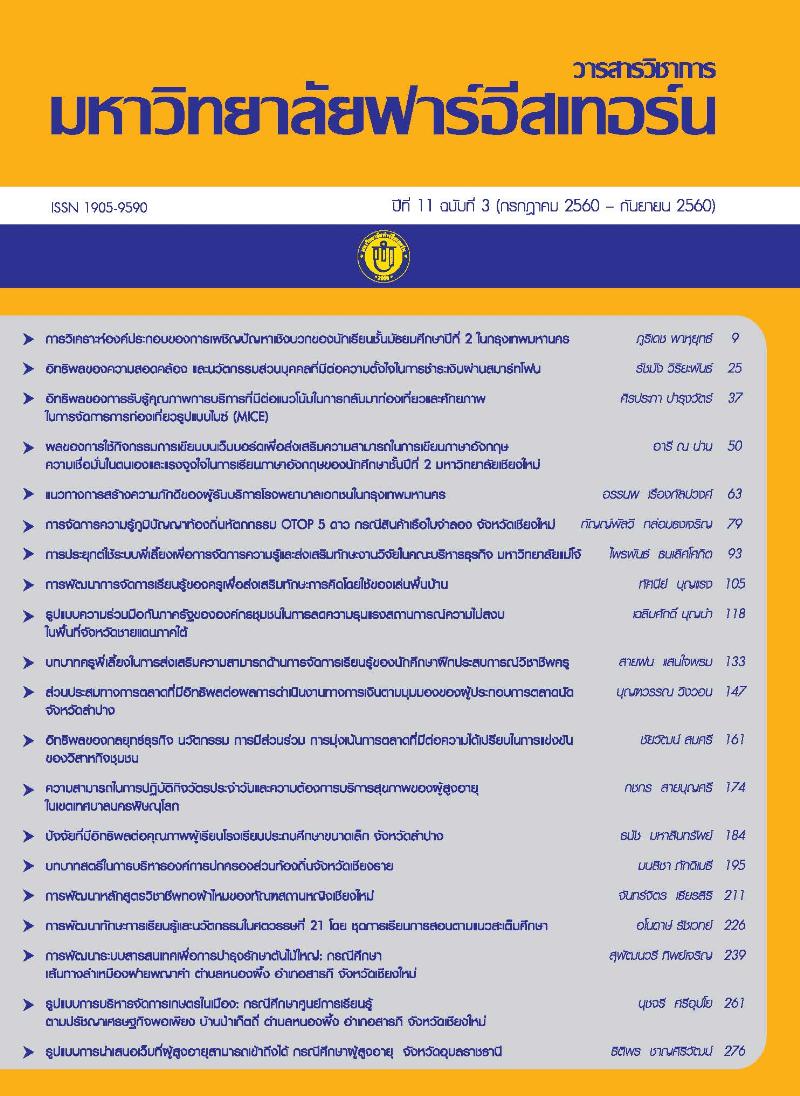รูปแบบความร่วมมือกับภาครัฐขององค์กรชุมชนในการลดความรุนแรงสถานการณ์ความไม่สงบในพื้นที่จังหวัดชายแดนภาคใต้
Main Article Content
Abstract
บทความวิจยั นมี้ วี ตั ถุประสงคเ์ พอื่ ศึกษา 1) รปู แบบความรว่ มมือทสี่ ามารถนำไปสูก่ ารปฏิบตั กิ บั ภาครัฐ
ขององค์กรชุมชนในการลดความรุนแรงสถานการณ์ความไม่สงบในพื้นที่จังหวัดชายแดนภาคใต้ 2) ปัจจัย
ที่มีความสัมพันธ์กับความร่วมมือกับภาครัฐขององค์กรชุมชนเพื่อการลดความรุนแรงสถานการณความไม่สงบ
ในพื้นที่จังหวัดชายแดนภาคใต้ ผู้ให้ข้อมูลสำคัญ คือ กลุ่มองค์กรชุมชนที่มีสถานภาพเป็นองค์กรจดทะเบียน
ทงั้ ในเขตเมืองและชนบท ประกอบดว้ ย ผนู้ าํ กรรมการ หรือสมาชิกกลุม่ ผไู้ ดร้ บั มอบหมายจากตัวแทนองคก์ ร
ชุมชนในพื้นที่ 3 จังหวัดชายแดนภาคใต้ และ 4 อำเภอ จังหวัดสงขลา เก็บข้อมูลด้วยการสัมภาษณ์เจาะลึก
(In-depth Interview) จาํ นวน 16 คน และวิธกี ารสนทนากลุม่ ยอ่ ย (Focus Group Discussion) จาํ นวน 10 คน
ใช้วิธีการวิเคราะห์เนื้อหา สรุปผลการวิจัยดังนี้ 1) รูปแบบความร่วมมือที่กับภาครัฐกับองค์กรชุมชนใน
การลดความรุนแรงในพนื้ ที่จงั หวัดชายแดนภาคใต ้ประกอบดว้ ย 3 รปู แบบ คอื รปู แบบความรว่ มมือแบบสงั่ การ
รูปแบบความร่วมมือแบบหุ้นส่วน และรูปแบบความร่วมมือแบบพันธมิตร 2) ปัจจัยที่มีความสัมพันธ์ต่อ
ความร่วมมือกับภาครัฐขององค์กรชุมชนเพื่อการลดความรุนแรงสถานการณ์ความไม่สงบในพื้นที่
จังหวัดชายแดนภาคใต้ คือ ปัจจัยการแสดงออกในเชิงอัตลักษณ์ ปัจจัยความเหมาะสมของนโยบาย และ
ปัจจัยสภาพโครงสร้างทางสังคม
The purpose of this research were to study 1) the collaborative model between public sectors
and community organizations to inhibit the insurgency in unrest areas of southernmost provinces
2) the factors regarding collaboration between government and community organizations to
decrease the violence in the unrest areas of southernmost provinces. The key informants of this
study were the community organizations registered in the urban and countryside. They consist of
leaders, committees, or representatives of the community members who inhabit within three
southernmost provinces, along with four districts in songkhla. Data were collected by implementing
in-depth interview with sixteen people and focus group with ten people. Content Analysis.
The following consequences will be summarized below: 1) The three collaborative models between
public Sectors and community organizations to inhibit the insurgency in the unrest areas of
southernmost provinces were commanding model, partnership model and alliance model. 2) The
three factors as to collaboration between public sectors and community organizations to inhibit the
insurgency in unrest areas of southernmost provinces were social structure, identity expression
and appropriate policy.
Article Details
1. Any views and comments in the FEU Academic Review Journal are the authors’ views. The editorial staff have not to agree with those views and it is not considered as the editorial’s responsibility.
2. The responsibility of content and draft check of each article belongs to each author. In case, there is any lawsuit about copyright infringement. It is considered as the authors’ sole responsibility.
3. The article copyright belonging to the authors and the Far Eastern University are copyrighted legally. Republication must be received direct permission from the authors and the Far Eastern University in written form.
References
กรมยุทธศึกษาทหารบก. (2549). การก่อความไม่สงบ. กรุงเทพฯ: โรงพิมพ์กรมยุทธศึกษาทหารบก.
ประเวศ วะสี. (2542). เศรษฐกิจพอเพียงและประชาสังคม แนวทางพลิกฟื้นเศรษฐกิจสังคม. กรุงเทพฯ: หมอชาวบ้าน.
ศูนย์การเฝ้าระวังสถานการณ์ภาคใต้. (2558). นโยบายการบริหารและการพัฒนาจังหวัดชายแดนภาคใต้ พ.ศ. 2555-2557. สืบค้นเมื่อ 2 ธันวาคม 2558, จาก http://www.deepsouthwatch.org/node/3018.
สถาบันส่งเสริมการบริหารกิจการบ้านเมืองที่ดี. (2550). รายงานการศึกษาเบื้องต้นที่แสดงถึงผลการศึกษารูปแบบการพัฒนาระบบราชการที่ดีของประเทศต่าง ๆ และแนวคิดทฤษฎีการบริหารจัดการการภาครัฐใหม่ ๆ ที่สอดรับกับบริบทของการพัฒนาระบบราชการไทย. (อัดสำเนา).
สำนักงานแผนงานและงบประมาณ สำนักงานตำรวจแห่งชาติ. (ม.ป.ป). การเกิดความไม่สงบ 3 จังหวัดชายแดนภาคใต้. ม.ป.ท.
เสริมศักดิ์ วิสาลาภรณ์. (2555). รายงานวิจัย เรื่อง รูปแบบการบริหารจัดการศึกษาในจังหวัดชายแดนภาคใต้. กรุงเทพฯ: ห้างหุ้นส่วนจำกัด วี.ที.ซี. คอมมิวนิเคชั่น.
Agranoff, R. (2006). Inside Collaborative Networks : Ten Lessons for Public Managers [Special issues]. Public Administrative Review. 66(s1), 56-65.
Agranoff, R. & McGuire, M. (2003). Collaborative Public Management: New Strategies for Local Government. Washington, D.C.: Georgetown University Press.
Almond, G. A., & Powell, G. B. (1978). Comparative politics: System, process, and policy. Boston: Little, Brown.
Berlo, D. K. (1960). The Process of Communication : An Introduction to Theory and Practice. New York: Holt Rinehart and Winston.
Boonsuaykhwan, N. (2006). Civil society practice in using state power in Pakpanang basin, Nakhon Si Thammarat. Program of Doctor of Philosophy in Politics. Ramkhamhaeng University. (in Thai).
Budget Policy and Planning Office, National Police Agency. (n.d.). Insurgency in Three Southernmost Provinces. n.d. (in Thai).
Byrne, A., & Hansberry, J. (2007). Collaboration: Leveraging resources and expertise. New Directions for Youth Development. 2007(114), 75-84.
Chaijaroenwatana, B., Kajornboon, S., Siammai, D., & Jongrungrote, W. (2008). The Study of Policy, Measure, and Solution to Prevent Insurgent Problems and Development in Southernmost Provinces. Prince of Songkhla University: Research Funded by National Research Council of Thailand. (in Thai)
Byrne, A., & Hansberry, J. (2007). Collaboration: Leveraging resources and expertise. New Directions for Youth Development. 2007(114), 75-84.
Cheow, E. T. C. (2003). The Changing Face of Terrorism in Southeast Asia. PacNet, Retrieved March 10, 2015, from http:// www.csis.org/media/csis/pubs/ pac0334.pdf.
Connor, T. O. (2009). The Criminology of Terrorism: Theories and Models. Terrorism in America. London: Jones and Bartlett Publishers, LLC.
Creswell, J. W. & Plano, C. V. L. (2011). Design and conducting mixed methods research. (2nd ed.). California: Sage Publications Ltd.
Croissant, A. (2005). Unrest in South Thailand : Contours, Causes and Consequences Since 2001. Strategic Insights. 4(2), 1-17.
Denhardt, R. B., & Denhardt, J. V. (2000). The New Public Service: Serving Rather than Steering. Public Administration Review. 60(6), 549-559.
Higgins, J. M., & Vincze, J. W. (1986). Strategic management and organizational policy: text and cases (3rd ed.). New York: CBS International Editions.
Jaikaew, A. (2010). An appropriated-administrative model of the Three Southernmost Provinces and application. Songklanakarin: Journal of Social Sciences and Humanities. 16(6), 989-1011.
Keet, M. (2005). Causes of Terrorism. Retrieved November 25, 2014, from http://www.meteck.org/causesTerrorism.html.
Manyin, M. E., Chanlett-Avery, E., Croin, R., Niksch, L. A., & Vaughn, B. (2004). Terrorism in Southeast Asia. Retrieved May 12, 2015, from http://oai.dtic.mil/oai/oai?verb=
getRecord&metadataPrefix=html&identifier=ADA476229.
Mondy, R. W., Sharplin, A., & Flippo, E. B. (1988). Management : Concepts and Practices. Boston: Allyn and Bacon.
Mongkolnchaiarunya, J. (1997). The Community Study for Development. Teaching Material for Department of Community Development. Bangkok: Faculty of Social Administration, Thammasat University. (in Thai)
Nakata, T. (2010). Terrorism in Southernmost Provinces: Main Causes. Songklanakarin: Journal of Social Sciences and Humanities. 16(6), 911 - 932. (in Thai)
Puang-ngam, K. (2008). The Lesson Synthesis on Community Management for Self-Sufficiency of DLA: Case Study of DLA in Japan. Journal of Social Sciences. 16(1), 5-20. (in Thai)
Rabasa, A., & Chalk, P. (2012). Non-Traditional Threats and Maritime Domain Awareness in the Tri –Border Area of Southeast Asia. Santa Monica: RAND Corporation.
Smith, A. L. (2004). Trouble in Thailand’s Muslim South: Separatism, not Global Terrorism. Asia Pacific Center for Security Studies. 3(10), 1-4.
Transparency International. (2004). Annual Report Transparency International 2004. Jana Kotalik, Taslima Ahmed and Amber Poroznuk (editors). Köllen Druck+Verlag GmbH: Berlin.
Vangen, S., & Huxham, C. (2010). Introducing the theory of collaborative advantage. In: Osborne, S (ed.) The New Public Governance? Emerging perspectives on the theory and practice of public governance. London, Routledge.
